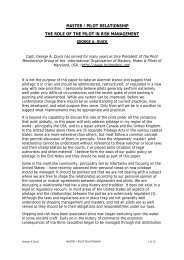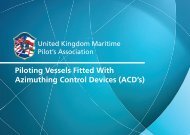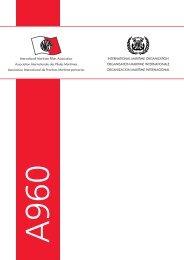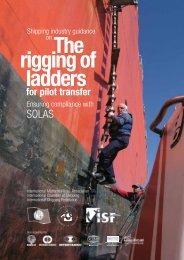Pilot Transfer Arrangements - International Maritime Pilots' Association
Pilot Transfer Arrangements - International Maritime Pilots' Association
Pilot Transfer Arrangements - International Maritime Pilots' Association
Create successful ePaper yourself
Turn your PDF publications into a flip-book with our unique Google optimized e-Paper software.
Ensuring Safe Rigging for <strong>Pilot</strong>sThe IMO Convention for Safety of Life at Sea(SOLAS Chapter V, Regulation 23) sets out theprincipal requirements for the rigging of pilot ladders.These provisions are set out in the diagram containedin this brochure. This diagram can be downloaded atwww.impahq.org (on home page, click ‘Downloads’).It is also reproduced in the ICS Bridge Procedures Guide.There is further detailed technical specification forpilot ladders in IMO Resolution A.1045(27). Shippingcompanies have a legal obligation to provide aconforming ladder and ship-borne fittings. If seafarersare uncertain about any of the requirements, they shouldalways ask their supervising officer for advice.The two major causes of accidents are defects in theladder treads or sideropes (see diagram) or a lack ofproper attachment of the ladder to the vessel.Seafarers should always check the condition of theladder before it is rigged and also ensure it is secure tothe ship. Whilst this is done, seafarers should always takecare of their own safety, wearing a life jacket (and alife-line if appropriate).Poor and incorrect securing methodManagement IssuesShipping companies should ensure that: on board have a full understanding of the requirements.IMPA is able to provide an advice document for newconstruction designs.On Board IssuesThe Master and officers should: ladders, ensuring that SOLAS requirements are met At all times during the rigging, use and de-rigging of anypilot transfer arrangements there should be no risk tothe ship’s crew. Crew members should not normally berequired to leave the protection of the ship’s safety railsor bulwarks. A life line or safety harness should be worn ifthere is any risk of falling.New SOLAS requirements from 1 July 2012Ships constructed after the 1 July 2012 mustcomply with the new equipment and arrangementrequirements of SOLAS Regulation V/23. Equipment andarrangements replaced on or after the 1 July 2012 onexisting ships, shall, so far is reasonable and practicable,comply with the requirements of this regulation.These requirements include the securing of anaccommodation ladder to the ship’s side, whenused in conjunction with the pilot ladder, and theprohibited use of mechanical pilot hoists.Summary<strong>Pilot</strong>s have the right to decline to board vessels offeringdefective ladders, which can result in serious delay.<strong>Pilot</strong>s are also entitled to report defects in boardingladders to port state control authorities, which couldlead to a full PSC inspection with the risk of delay andfinancial penalties.A pilot who has climbed a sound ladder, well rigged,and attended by an officer and a deck party will be inthe right frame of mind to give his best attention to thesafety of the vessel.








